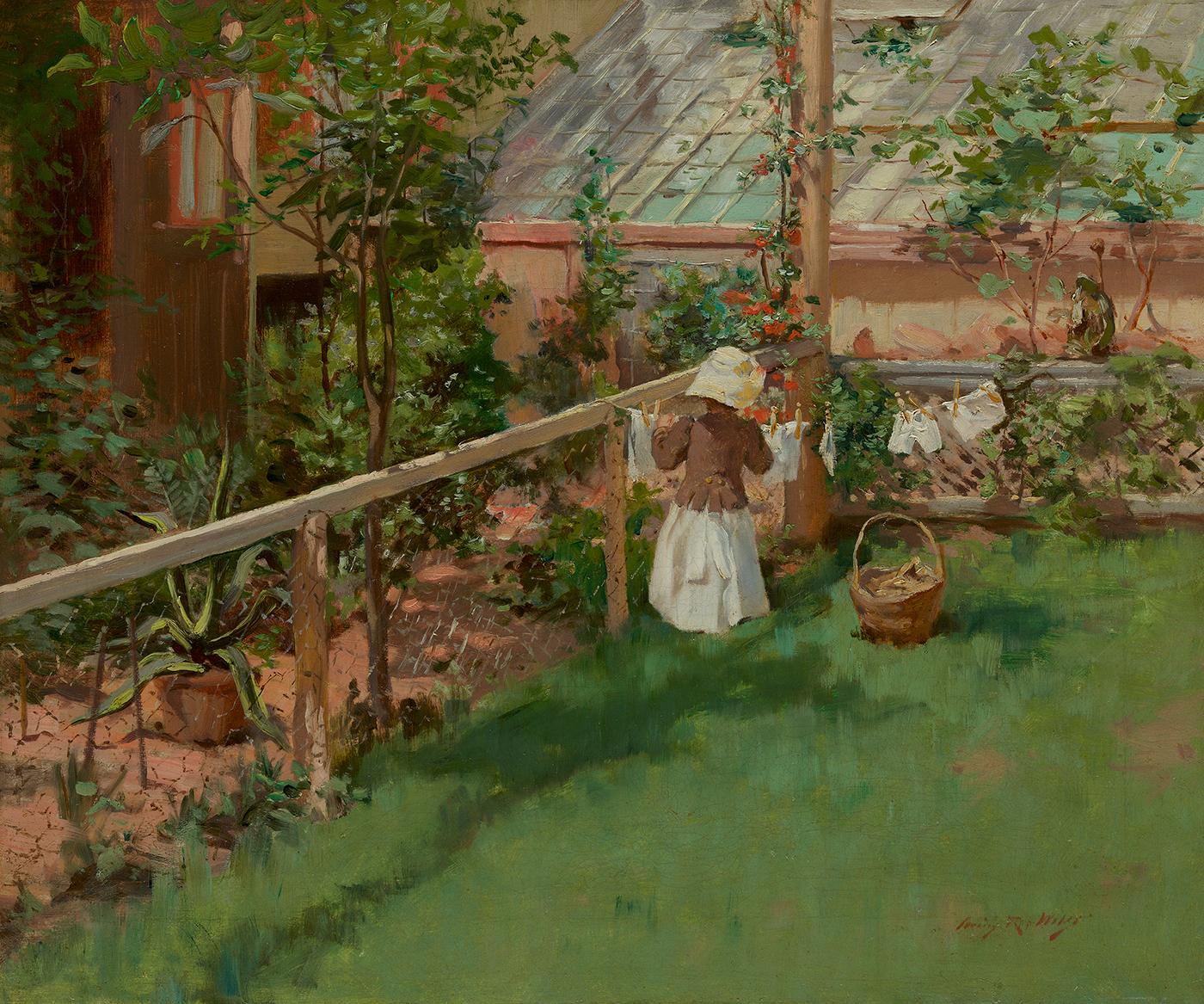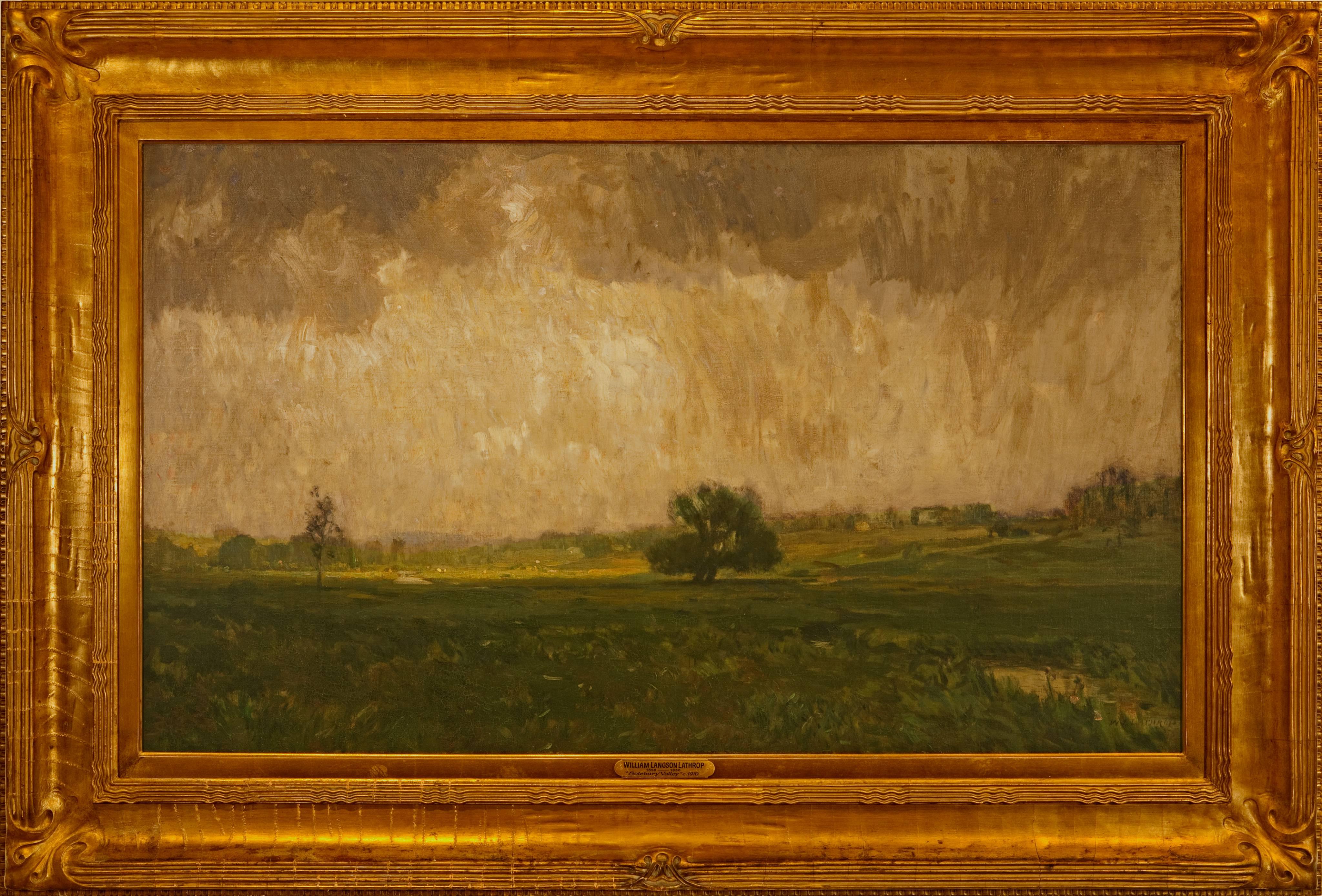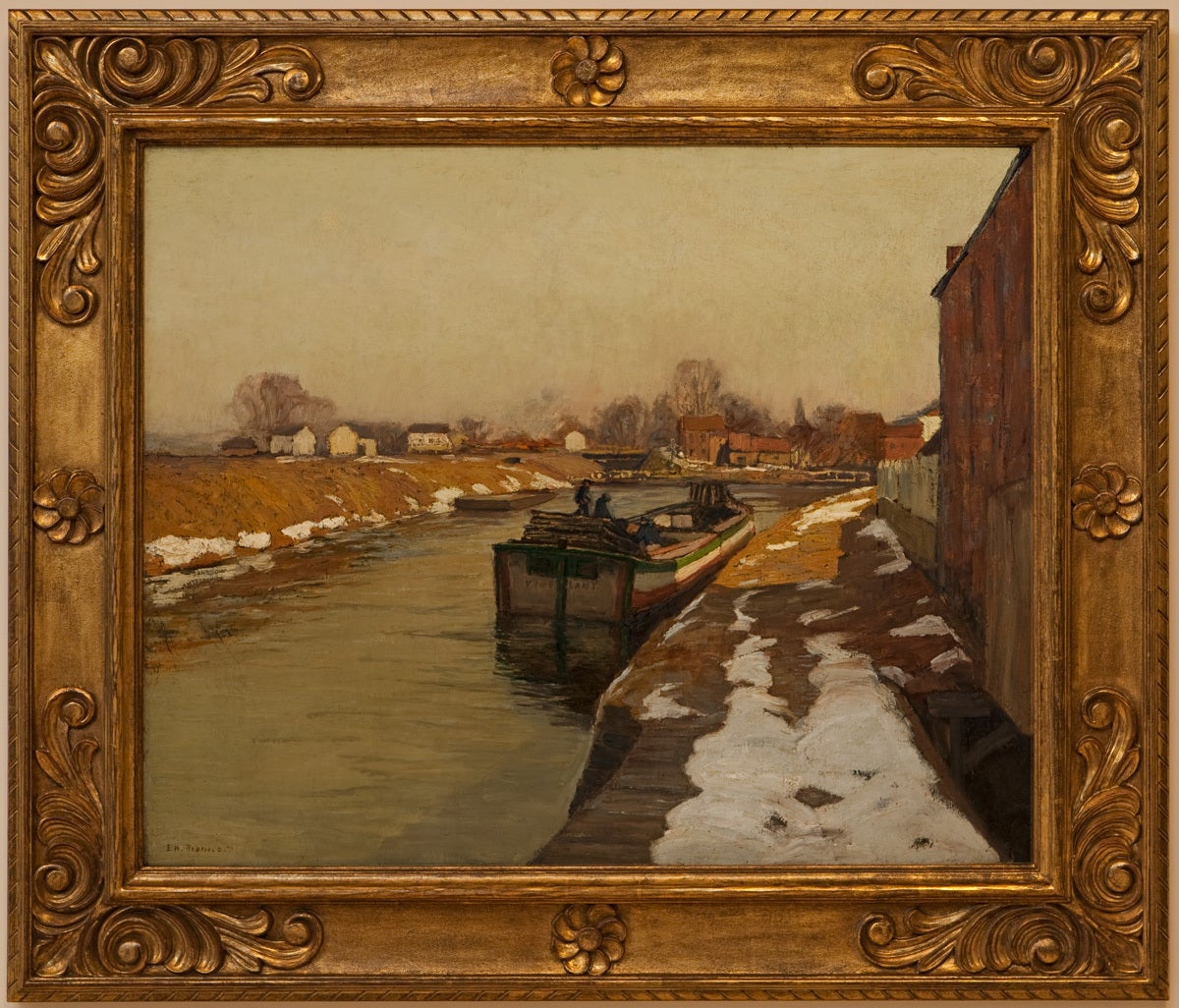Items Similar to The Way In Light (Traditional Realist Oil Landscape of Stone Wall Path)
Want more images or videos?
Request additional images or videos from the seller
1 of 12
Susan Hope FogelThe Way In Light (Traditional Realist Oil Landscape of Stone Wall Path)
About the Item
"A Way in Light" by Susan Hope Fogel
oil on canvas panel
9 x 12 inches, 14.5 x 17 inches in gold leaf frame
wire on reverse for easy installation
signature in lower left
Susan Hope Fogel explores a fascination with light in her approach to traditional, realist landscape painting.
Among the star traits of "A Way In Light" are the rich shadows that span the stone walk way between trees in summer. Sunlight streams through the canopy and catches on random branches. A pathway appears to lead into a darker patch of woods, a gateway into the unknown. This work is perfectly complimented with a gold frame whose design parallels the tradition of the painting style itself.
Susan Hope Fogel has remained steadfast in painting the light, i.e. following a timeless tradition that culminated in the mid-eighteen-hundreds under the banner of "The French Barbizon School." Briefly stated, it was a long-held belief that "real" painting was a matter of capturing the play of light on the forms and colors of natural phenomena. The more we learned and observed how light revealed the world we live in, the "realer" our art would be — "realism" or "realistic" or "representational" art, therefore, would be the mainstay — so manifestly demonstrated in Susan's exhibit of "realistic" motifs.
After spending many years painting in the style of traditional realism , Susan had the opportunity to work with Paul Ching-Bor to explore a new form of expression in Deconstructionist Watercolor. Working in New York City with a group of large scale watercolorists, Susan soon found herself fascinated by the experimental quality of this new media. A great departure from the world of realism this media allowed for great freedom of expression creating from an intuitive place, deep within, instead of inspiration from the outside world.
The focus of her work has now shifted to large scale watercolor painting with an emphasis on abstraction of landscape and cityscape.
Susan has studied in art schools in New York City including: classical drawing at The New York Academy of Art, figure and portrait painting at The Art Students League and The National Academy of Design. She credits John Philip Osborne for developing her painter’s eyes at The Ridgewood Art Institute.
- Creator:Susan Hope Fogel (American)
- Dimensions:Height: 14.5 in (36.83 cm)Width: 17 in (43.18 cm)Depth: 1 in (2.54 cm)
- Medium:
- Movement & Style:
- Period:
- Condition:
- Gallery Location:Hudson, NY
- Reference Number:1stDibs: LU2279392782
Susan Hope Fogel
There is no doubt that Susan Hope Fogel will be concerned one of the 'modern masters' of her time. Early in her career, Fogel held a distinctly classical approach to traditional realism as evidenced in her landscape and still life paintings. Created in oil, painted in studio or plein air, she always paints the light. When one considers the difficulty in understanding the role of light on form and color, especially its ever-changing presence and effect, it is perhaps easier to understand the dismissal of classical training by both "modern" artists and the numerous middlemen involved in the artworld of today. In 2015, after spending many years painting in the style of traditional realism, Susan Hope Fogel had the opportunity to work with Paul Ching-Bor to explore a new form of expression in Deconstructionist Watercolor. Working in New York City with a group of large scale watercolorists, Fogel soon found herself fascinated by the experimental quality of this new media. A great departure from the world of realism this media allowed for great freedom of expression creating from an intuitive place, deep within, instead of inspiration from the outside world. The focus of her work has now shifted to large scale watercolor painting with an emphasis on abstraction of landscape and cityscape. Susan has studied in art schools in New York City including: classical drawing at The New York Academy of Art, figure and portrait painting at The Art Students League and The National Academy of Design. She credits John Philip Osborne for developing her painter’s eyes at The Ridgewood Art Institute.
About the Seller
5.0
Platinum Seller
These expertly vetted sellers are 1stDibs' most experienced sellers and are rated highest by our customers.
Established in 1991
1stDibs seller since 2013
544 sales on 1stDibs
Typical response time: 2 hours
- ShippingRetrieving quote...Ships From: Hudson, NY
- Return PolicyA return for this item may be initiated within 3 days of delivery.
More From This SellerView All
- Untitled (Contemporary Impressionist View of New York City from Above)Located in Hudson, NYUntitled (Contemporary Impressionist View of New York City from Above) Excellent Condition 17.5 x 17 inches framed in brown wood Signed Verso This contemporary impressionistic paintings...Category
2010s Impressionist Landscape Paintings
MaterialsCanvas, Oil
- Potato Barn (Impressionist Rural Landscape, Sun Dappled Country Road on a Farm)By Harry OrlykLocated in Hudson, NYImpressionist style en plein air landscape painting on linen of a sun dappled dirt road leading to a barn #5963 Potato Barn, 2022 painted by Harry Orlyk oil on linen, ready to hang as is 14 x 14.5 inches Harry Orlyk is celebrated for his ability to capture rural country landscapes with impressionistic brushstrokes and bright color palettes. Painting daily, the artist drives throughout the upstate New York, stopping to observe and paint 'en plain air' whenever and wherever a landscape strikes him. This painting is a perfect example of Orlyk's impressionistic aesthetic. Here, the artist captures a winding dirt road leading to an old potato barn, likely sited on a neighbor's farm close to the artist's home. A wonderful blend of luscious color is layered to create the foreground. The application of paint and color feel effortless, while the balance of the composition suggests the experience that comes from a lifetime of painting plein air and completely in the moment. Orlyk surrounds to teh natural beauty, its climate, and truly embodies the romantic truth of his beloved rural landscape. About the artist: Harry Orlyk was born in Troy, New York in 1947. In 1971 after graduating college, he went on to graduate school at the University of Nebraska at Lincoln . Over the next nine years, he was influenced by several Nebraskan artists. "Still-life painter Robin Smith taught me how to use paint without turpentine - to paint from the tube." He also admits the influence of photographer Lawrence McFarland who taught him what spiritual space was, and how to emphasize it. Lastly he credits well-known Lincoln painter Keith Jacobshagen...Category
2010s Impressionist Landscape Paintings
MaterialsLinen, Oil, Board
- 5540 New Year's Day: Impressionist En Plein Air Landscape Painting on LinenBy Harry OrlykLocated in Hudson, NYImpressionistic, en plein air landscape oil painting on linen with a bright yellow palette of a rural country farm during a winter sunset #5540 New Year's Day, in Late Day Light, 201...Category
2010s Impressionist Landscape Paintings
MaterialsOil, Board, Linen
- Braymer Hill: Impressionist En Plein Air Landscape Painting of Green CountryBy Harry OrlykLocated in Hudson, NYImpressionist style en plein air landscape painting on linen of a rural country farm with green fields and bright blue sky "Braymer Hill," an upstate New York landscape, painted plei...Category
2010s Impressionist Landscape Paintings
MaterialsLinen, Board, Oil
- Ted's Farm: Impressionist En Plein Air Landscape Painting of a Country FarmBy Harry OrlykLocated in Hudson, NYImpressionist en plein air landscape painting on linen of a rural country farm during late summer with lush green fields and blue mountains 'Ted's Farm', an upstate New York landsca...Category
2010s Impressionist Landscape Paintings
MaterialsLinen, Board, Oil
- #5418 Washington County Vineyard (Impressionistic Green Country Landscape)By Harry OrlykLocated in Hudson, NYoil on linen on homasote board, unframed 14.5 x 19 inches Harry Orlyk is celebrated for his ability to capture a rural country landscape with impressionistic brushstrokes and a bright color palette. Painting daily, the artist drives throughout the upstate New York, stopping to observe and paint 'en plain air' whenever and wherever a landscape strikes him. Orlyk prefers to leave his canvases unframed to reveal the exposed linen which are nailed to sturdy homasote boards for easy installation. '#5418 A Washington County Vineyard' is a perfect example of Orlyk's impressionistic aesthetic. Here, the artist captures a lush green field towards the end of summer. Orange leaves begin to appear atop green trees, creating a bright contrast with the blue mountains lining the horizon. Thick layers of paint are applied with expressive brushstrokes and culminate onto a textured surface. About the artist: Harry Orlyk was born in Troy, New York in 1947. In 1971 after graduating college, he went on to graduate school at the University of Nebraska at Lincoln . Over the next nine years, he was influenced by several Nebraskan artists. "Still-life painter Robin Smith taught me how to use paint without turpentine - to paint from the tube." He also admits the influence of photographer Lawrence McFarland who taught him what spiritual space was, and how to emphasize it. Lastly he credits well-known Lincoln painter Keith Jacobshagen...Category
2010s Impressionist Landscape Paintings
MaterialsOil, Linen
You May Also Like
- At the ClotheslineBy Irving Ramsey WilesLocated in New York, NYSigned lower right: Irving R. WilesCategory
Late 19th Century American Impressionist Landscape Paintings
MaterialsCanvas, Oil
- "Alley Fiends"By John R. GrabachLocated in Lambertville, NJJim’s of Lambertville is proud to offer this artwork by: John R. Grabach (1886 - 1981) John Grabach was a highly regarded New Jersey artist, teacher, and author of the classic text...Category
1930s American Impressionist Landscape Paintings
MaterialsCanvas, Oil
- "Forest Strongholds"By John F. CarlsonLocated in Lambertville, NJSigned lower right. Complemented by a hand carved and gilt frame. Exhibited at the National Academy of Design, 1928Category
20th Century American Impressionist Landscape Paintings
MaterialsCanvas, Oil
- "Solebury Valley"By William Langson LathropLocated in Lambertville, NJSigned lower right. Complemented by a period frame. William L. Lathrop (1859-1938) Deemed “Father of the New Hope Art Colony”, William Langson Lathrop was born in Warren, Illinois. He was largely self-taught, having only studied briefly with William Merritt Chase in 1887, at the Art Students League. Lathrop first moved east in the early 1880s, and took a job at the Photoengraving Company in New York City. While there, he befriended a fellow employee, Henry B. Snell. The two men became lifelong friends and ultimately, both would be considered central figures among the New Hope Art Colony. Lathrop's early years as an artist were ones of continuing struggle. His efforts to break through in the New York art scene seemed futile, so he scraped enough money together to travel to Europe with Henry Snell in1888. There he met and married an English girl, Annie Burt. Upon returning to New York, he tried his hand at etching, making tools from old saw blades...Category
1910s American Impressionist Landscape Paintings
MaterialsCanvas, Oil
- Winter MoonlightBy George William SotterLocated in Lambertville, NJsigned lower rightCategory
1910s American Impressionist Landscape Paintings
MaterialsCanvas, Oil
- "The Canal"By Edward Willis RedfieldLocated in Lambertville, NJJim’s of Lambertville is proud to offer this artwork. Signed lower left. Complemented by a hand carved and gilt frame. Illustrated in "Edward Redfield: Just Values and Fine Seeing" by Constance Kimmerle and the Pennsylvania Academy of the Fine Arts's Exhibition of Paintings by Edward Redfield (April 17 to May 16, 1909) brochure Edward Willis Redfield (1869 - 1965) Edward W. Redfield was born in Bridgeville, Delaware, moving to Philadelphia as a young child. Determined to be an artist from an early age, he studied at the Spring Garden Institute and the Franklin Institute before entering the Pennsylvania Academy from 1887 to 1889, where he studied under Thomas Anshutz, James Kelly, and Thomas Hovenden. Along with his friend and fellow artist, Robert Henri, he traveled abroad in 1889 and studied at the Academie Julian in Paris under William Bouguereau and Tony Robert-Fleury. While in France, Redfield met Elise Deligant, the daughter of an innkeeper, and married in London in 1893. Upon his return to the United States, Redfield and his wife settled in Glenside, Pennsylvania. He remained there until 1898, at which time he moved his family to Center Bridge, a town several miles north of New Hope along the Delaware River. Redfield painted prolifically in the 1890s but it was not until the beginning of the twentieth century that he would develop the bold impressionist style that defined his career. As Redfield’s international reputation spread, many young artists gravitated to New Hope as he was a great inspiration and an iconic role model. Edward Redfield remained in Center Bridge throughout his long life, fathering his six children there. Around 1905 and 1906, Redfield’s style was coming into its own, employing thick vigorous brush strokes tightly woven and layered with a multitude of colors. These large plein-air canvases define the essence of Pennsylvania Impressionism. By 1907, Redfield had perfected his craft and, from this point forward, was creating some of his finest work. Redfield would once again return to France where he painted a small but important body of work between 1907 and 1908. While there, he received an Honorable Mention from the Paris Salon for one of these canvases. In 1910 he was awarded a Gold Medal at the prestigious Buenos Aires Exposition and at the Panama-Pacific Exposition of 1915 in San Francisco, an entire gallery was dedicated for twenty-one of his paintings. Since Redfield painted for Exhibition with the intent to win medals, his best effort often went into his larger paintings. Although he also painted many fine smaller pictures, virtually all of his works were of major award-winning canvas sizes of 38x50 or 50x56 inches. If one were to assign a period of Redfield’s work that was representative of his “best period”, it would have to be from 1907 to 1925. Although he was capable of creating masterpieces though the late 1940s, his style fully matured by 1907 and most work from then through the early twenties was of consistently high quality. In the later 1920s and through the 1930s and 1940s, he was like most other great artists, creating some paintings that were superb examples and others that were of more ordinary quality. Redfield earned an international reputation at a young age, known for accurately recording nature with his canvases and painting virtually all of his work outdoors; Redfield was one of a rare breed. He was regarded as the pioneer of impressionist winter landscape painting in America, having few if any equals. Redfield spent summers in Maine, first at Boothbay Harbor and beginning in the 1920s, on Monhegan Island. There he painted colorful marine and coastal scenes as well as the island’s landscape and fishing shacks. He remained active painting and making Windsor style furniture...Category
Early 1900s American Impressionist Landscape Paintings
MaterialsCanvas, Oil
Recently Viewed
View AllMore Ways To Browse
French Stone Light
Stone So
Lighted Wall Art Installations
Traditional Large Wall Paintings
French Star Light
Eighteen Stone
Eighteen Stones
Framed Banner
Banners Canvas
Large Wall Oil Panels
French Gold Wall Panel
Wood Branch Wall Art
Gold Frame 9 X 12
Landscape Painting Stone Wall
Gold Leaf Tree Wall
Large Impressionist Cityscape Paintings
I Ching
Osborne Oil Paintings






